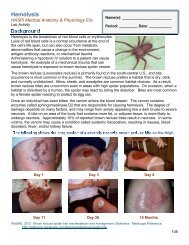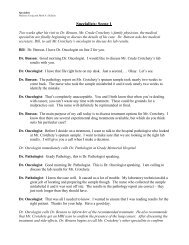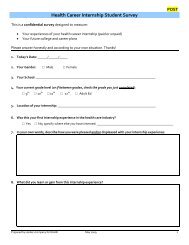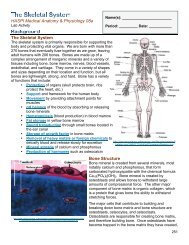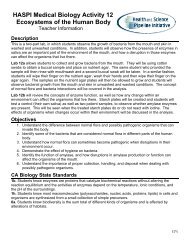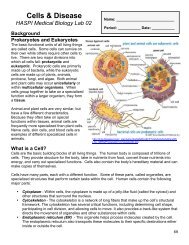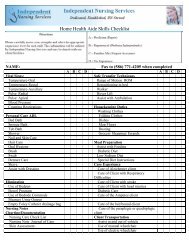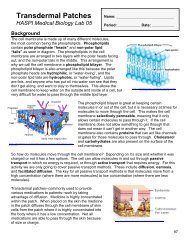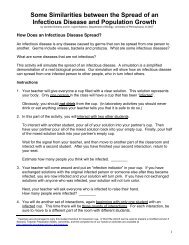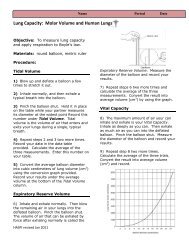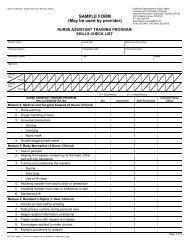Bonding: Intermolecular Forces - haspi
Bonding: Intermolecular Forces - haspi
Bonding: Intermolecular Forces - haspi
Create successful ePaper yourself
Turn your PDF publications into a flip-book with our unique Google optimized e-Paper software.
Oakland Schools Chemistry Resource Unit<strong>Intermolecular</strong> <strong>Forces</strong>Brook R. KirouacDavid A. Consiglio, Jr.Southfield‐Lathrup High SchoolSouthfield Public Schools
Content Statements:C2.2: Chemical Potential Energy<strong>Bonding</strong>: <strong>Intermolecular</strong> <strong>Forces</strong>Potential energy is stored whenever work must be done to change the distancebetween two objects. The attraction between the two objects may be gravitational,electrostatic, magnetic, or strong force. Chemical potential energy is the result ofelectrostatic attractions between atoms.C3.3: Heating ImpactsHeating increases the kinetic (translational, rotational, and vibrational) energy of theatoms composing elements and the molecules or ions composing compounds. As thekinetic (translational) energy of the atoms, molecules, or ions increases, thetemperature of the matter increases. Heating a sample of a crystalline solid increasesthe kinetic (vibrational) energy of the atoms, molecules, or ions. When the kinetic(vibrational) energy becomes great enough, the crystalline structure breaks down, andthe solid melts.C4.3: Properties of SubstancesDifferences in the physical and chemical properties of substances are explained by thearrangement of the atoms, ions, or molecules of the substances and by the strength ofthe forces of attraction between the atoms, ions, or molecules.C4.4: Molecular PolarityThe forces between molecules depend on the net polarity of the molecule asdetermined by shape of the molecule and the polarity of the bonds.C5.4: Phase/Change DiagramsChanges of state require a transfer of energy. Water has unusually high-energychanges associated with its changes of state.
Content Expectations:C2.1c: Compare qualitatively the energy changes associated with melting various typesof solids in terms of the types of forces between the particles in the solid.C3.3B: Describe melting on a molecular level.C4.3A: Recognize that substances that are solid at room temperature have strongerattractive forces than liquids at room temperature, which have stronger attractiveforces than gases at room temperature.C4.3c: Compare the relative strengths of forces between molecules based on themelting point and boiling point of the substances.C4.3d: Compare the strength of the forces of attraction between molecules of differentelements. (For example, at room temperature, chlorine is a gas and iodine is a solid.)C4.3f: Identify the elements necessary for hydrogen bonding (N, O, and F).C4.3g: Given the structural formula of a compound, indicate all the intermolecularforces present (dispersion, dipolar, hydrogen bonding).C4.4a: Explain why at room temperature different compounds can exist in differentphases.C5.4c: Explain why both the melting point and boiling points for water are significantlyhigher than other small molecules of comparable mass (e.g., ammonia and methane)
Instructional Background Information:Melting on a Molecular Level: Melting involves the disruption of the crystal lattice ofa solid via the absorption of kinetic energy by the molecules in the lattice from theirsurroundings. As the forces holding the lattice together increase in strength so doesthe melting point of the solid.Strong <strong>Forces</strong>: Ionic bonding, metallic bonding, and network-covalent bonding.Strong intermolecular forces result in room temperature solids with high melting andboiling points.Metallic and Network <strong>Bonding</strong> is difficult to quantify.Ionic <strong>Bonding</strong>: Ionic bonds are the result of electrostatic attraction betweenpositive and negative ions. Ionic bonding is directly proportional to ionic chargeand inversely proportional to ionic size.Weak <strong>Forces</strong>: Hydrogen bonding, dipole-dipole interactions, London dispersionforces.Hydrogen <strong>Bonding</strong>: Hydrogen bonding is the unusually strong dipole-dipoleinteraction that occurs when a highly electronegative atom (N, O, or F) is bondedto a hydrogen atom. This bond nearly strips the hydrogen atom of its electronsleaving, essentially, a naked proton. This proton is highly attracted to theelectron pairs on nearby molecules.Hydrogen bonding is significantly stronger than the dipole-dipole interactionswhich are in turn stronger than London dispersion forces. Hydrogen bondingexists only in molecules with an N-H, O-H, or F-H bond.Dipole-Dipole: Dipole-dipole interaction is the attraction between a partiallynegative portion of one molecule and a partially positive portion of a nearbymolecule. Dipole-dipole interaction occurs in any polar molecule as determinedby molecular geometry.www.lbl.gov/images/MicroWorlds/H2OH-bond.gifDipole-Dipole InteractionHydrogen <strong>Bonding</strong>(unusually strong Dipole-Dipole)
London Dispersion: London dispersion forces result from instantaneous nonpermanentdipoles created by random electron motion. London dispersion forcesare present in all molecules and are directly proportional to molecular size.Effects of <strong>Intermolecular</strong> <strong>Forces</strong>: The strength of intermolecular forces present ina substance is related to the boiling point and melting point of the substance. Strongerintermolecular forces cause higher melting and boiling points.EXAMPLES:CH 4 - Methane: has only very weak London dispersion forces (lowest b.p. &m.p.)CHCl 3 - Chloroform: has dipole-dipole interaction (moderate b.p. & m.p.)NH 3 - Ammonia: has hydrogen bonding and dipole-dipole interaction (high b.p.& m.p.)The <strong>Forces</strong> between MoleculesAll matter is held together by force. The force between atoms within a molecule is achemical or intramolecular force. The force between molecules is a physical orintermolecular force. We learned about intramolecular forces and the energy it took toovercome these forces, earlier in our chemical studies. Now we will focus onintermolecular forces.The Nature of <strong>Intermolecular</strong> <strong>Forces</strong>:The <strong>Intermolecular</strong> <strong>Forces</strong> (forces between molecules) are weaker than Intramolecular<strong>Forces</strong> (The Chemical Bonds within an Individual Molecule). This distinction is thereason we define the molecule in the first place. The properties of matter result fromthe properties of the individual molecule (resulting from chemical bonding) and how themolecules act collectively (resulting from intermolecular forces).<strong>Intermolecular</strong> <strong>Forces</strong> are longest-ranged (act strongly over a large distance) when theyare electrostatic. Interaction of Charge Monopoles (simple charges) is the longest-
anged electrostatic force.Charge-Charge forces (found in ionic crystals)For like charges (+,+) or (-,-), this force is always repulsive. For unlike charges (+,-),this force is always attractive.Charge-Dipole <strong>Forces</strong>:An uncharged molecule can still have an electric dipole moment. Electric Dipoles arisefrom opposite but equal charges separated by a distance. Molecules that possess adipole moment are called Polar molecules (remember the polar covalent bond?). Wateris polar and has a dipole moment of 1.85 Debye. The Debye is a unit of dipole momentand has a value of 3.336 x 10 -30 Coulomb meter.When salt is dissolved in water, the ions of the salt dissociate from each other andassociate with the dipole of the water molecules. This results in a solution called anElectrolyteThe force may be understood by decomposing each of the dipole into two equal butopposite charges and adding up the resulting charge-charge forces. Notice that theCharge-Dipole <strong>Forces</strong> depend on relative molecular orientation. This means that theforces can be attractive or repulsive depending on whether like or unlike charges arecloser together. On average, dipoles in a liquid orient themselves to form attractive
interactions with their neighbors, but thermal motion makes some instantaneousconfigurations exist fleetingly that are, in fact, repulsive.Dipole-Dipole forces exist between neutral polar molecules. Again, this force may beunderstood by decomposing each of the dipole into two equal but opposite charges andadding up the resulting charge-charge forces.The following table demonstrates the effect of the dipole moment on the boiling pointof several substances:SubstanceMolecular Mass[g/mol]Dipole moment[Debye]Normal Boiling Point[ K ]Propane 44 0.1 231Dimethyl ether 46 1.3 248Chloromethane 50 2.0 249Acetaldehyde 44 2.7 294Acetonitrile 41 3.9 355
Electrostatic forces are defined (categorized) by the symmetry of the partners involvedin the interaction. This symmetry is labeled by the first non-zero moment of the chargedistribution, i.e. Monopole, Dipole, Quadrupole, etc. Electrostatic forces only existbetween molecules with permanent moments of their charge distribution; Molecules donot have to distort or fluctuate in order to exhibit electrostatic intermolecular forces.Electrostatics cannot explain the whole story, however. Molecules that are round andhave no charge have no electrostatic forces between each other. How, then, do roundmolecules form liquids or solids?Inductive <strong>Forces</strong> and DispersionInductive forces arise from the distortion of the charge cloud induced by the presenceof another molecule nearby. The distortion arises from the electric field produced by thecharge distribution of the nearby molecule. These forces are always attractive butare in general shorter ranged than electrostatic forces. If a charged molecule (ion)induces a dipole moment in a nearby neutral molecule, the two molecules will sticktogether, even though the neutral molecule was initially round and uncharged:Other inductive forces exist (permanent dipole - induced dipole, etc.) but this one(charge-induced dipole) is the strongest.Inductive forces that result not from permanent charge distributions but fromfluctuations of charge, are not called inductive forces at all but are called LondonDispersion forces. These forces are ubiquitous but are most important in systems thathave no other types of molecular stickiness, like the rare gases. The rare gases may beliquefied, and it is dispersion forces that hold the atoms together (no electrostatic orinductive forces exits)
The movement of the electrons, even in the He atom, causes an instantaneous dipoleto be formed. The time-averaged dipole moment of the atom is still zero. This dipole,however fleeting, can induce a dipole in a neighboring atom, causing a force. This forceis always attractive but even shorter ranged (and weaker) than permanent dipoleinduceddipole forces.Size (Volume and Shape) determines the magnitude of the dispersion force. The biggerthe size, the larger the dispersion force.
Hydrogen <strong>Bonding</strong>The figure above shows the normal boiling point temperatures for several relatedsubstances. This boiling point diagram tells us about the intermolecular forces betweena homologous series of small hydrogen containing molecules. Look first at the Group IVhydrides, from CH 4 through SnH 4 . The boiling points of these molecules increase withincreasing mass, as one would expect. The group VI hydrides do the same thing, with
the notable exception of WATER! A special type of intermolecular force exists betweenwater molecules called hydrogen bonding, which raises its boiling point significantlywith respect to its isovalent homologs.Hydrogen is unique among the elements because it has a single electron which is also avalence electron. When this electron is hogged by another atom in a polar covalentbond, a significant fraction of the hydrogen nucleus becomes uncovered and the barenucleus desperately seeks to be covered by electrons from other atoms (modesty?).A Hydrogen Bond is the attractive interaction between two closed shell species thatarises from the link of the form A-H ... B, where A and B are highly electronegativeelements and B possesses a lone pair of electrons. Normally, hydrogen bonds only existwhen atoms A and B are Nitrogen, Oxygen, and Fluorine. If the element B is anionic(such as Cl - ) and thus a very good electron donor, it may also participate in hydrogenbonding. Hydrogen bonding is very important the function of proteins, as theseinteractions determine the way they fold (their shape), and this determines how theyreact in the cell. Fluorine hydrogen bonds not found too often in biochemistry, but canbe important in certain synthetic materials properties.Summary of Types of <strong>Intermolecular</strong> <strong>Forces</strong>
http://www.chem.ufl.edu/~itl/2045/lectures/lec_g.html
Three types of force can operate between covalent molecules:• Dispersion <strong>Forces</strong>also known as London <strong>Forces</strong> (named after Fritz London who first describedthese forces theoretically 1930) or as Weak <strong>Intermolecular</strong> <strong>Forces</strong> or as van derWaal's <strong>Forces</strong> (named after the person who contributed to our understanding ofnon-ideal gas behavior).• Dipole-dipole interactions• Hydrogen bondsRelative strength of <strong>Intermolecular</strong> <strong>Forces</strong>:• <strong>Intermolecular</strong> forces (dispersion forces, dipole-dipole interactions and hydrogenbonds) are much weaker than intramolecular forces (covalent bonds, ionic bondsor metallic bonds)• dispersion forces are the weakest intermolecular force (one hundredth-onethousandth the strength of a covalent bond); hydrogen bonds are the strongestintermolecular force (about one-tenth the strength of a covalent bond).• dispersion forces < dipole-dipole interactions < hydrogen bondsDispersion <strong>Forces</strong> (London <strong>Forces</strong>, Weak <strong>Intermolecular</strong> <strong>Forces</strong>, van derWaal's <strong>Forces</strong>)• are very weak forces of attraction between molecules resulting from:• momentary dipoles occurring due to uneven electron distributions inneighboring molecules as they approach one another• the weak residual attraction of the nuclei in one molecule for the electronsin a neighboring molecule.The more electrons that are present in the molecule, the stronger the dispersionforces will be.Dispersion forces are the only type of intermolecular force operating betweennon-polar molecules, for example, dispersion forces operate between hydrogen (H 2 )molecules, chlorine (Cl 2 ) molecules, carbon dioxide (CO 2 ) molecules, dinitrogentetroxide (N 2 O 4 ) molecules and methane (CH 4 ) molecules.Dipole-Dipole Interactions• are stronger intermolecular forces than Dispersion forces• occur between molecules that have permanent net dipoles (polar molecules), forexample, dipole-dipole interactions occur between SCl 2 molecules, PCl 3 moleculesand CH 3 Cl molecules.If the permanent net dipole within the polar molecules results from a covalentbond between a hydrogen atom and either fluorine, oxygen or nitrogen, theresulting intermolecular force is referred to as a hydrogen bond (see below).
• The partial positive charge on one molecule is electrostatically attracted to thepartial negative charge on a neighboring molecule.Hydrogen bonds• occur between molecules that have a permanent net dipole resulting fromhydrogen being covalently bonded to either fluorine, oxygen or nitrogen. Forexample, hydrogen bonds operate between water (H 2 O) molecules, ammonia(NH 3 ) molecules, hydrogen fluoride (HF) molecules, hydrogen peroxide (H 2 O 2 )molecules, alkanols (alcohols) such as methanol (CH 3 OH) molecules, andbetween alkanoic (caboxylic) acids such as ethanoic (acetic) acid (CH 3 COOH) andbetween organic amines such as methanamine (methyl amine, CH 3 NH 2 ).• are a stronger intermolecular force than either Dispersion forces or dipole-dipoleinteractions since the hydrogen nucleus is extremely small and positively chargedand fluorine, oxygen and nitrogen being very electronegative so that the electronon the hydrogen atom is strongly attracted to the fluorine, oxygen or nitrogenatom, leaving a highly localized positive charge on the hydrogen atom and highlynegative localized charge on the fluorine, oxygen or nitrogen atom. This meansthe electrostatic attraction between these molecules will be greater than for thepolar molecules that do not have hydrogen covalently bonded to either fluorine,oxygen or nitrogen.Effect of <strong>Intermolecular</strong> forces on melting and boiling points of molecularcovalent substances:Since melting or boiling result from a progressive weakening of the attractive forcesbetween the covalent molecules, the stronger the intermolecular force is, the moreenergy is required to melt the solid or boil the liquid.If only dispersion forces are present, then the moreelectrons the molecule has (and consequently themore mass it has) the stronger the dispersion forceswill be, so the higher the melting and boiling pointswill be.Consider the hydrides of Group IV, all of which arenon-polar molecules, so only dispersion forces actbetween the molecules.CH 4 (molecular mass ~ 16), SiH 4 (molecular mass ~32), GeH 4 (molecular mass ~ 77) and SnH 4(molecular mass ~ 123) can all be considered nonpolarcovalent molecules.As the mass of the molecules increases, so does thestrength of the dispersion force acting between themolecules, so more energy is required to weakenBoiling Points of Group IVHydrides
the attraction between the molecules resulting inhigher boiling point.If a covalent molecule has a permanent net dipolethen the force of attraction between thesemolecules will be stronger than if only dispersionforces were present between the molecules. As aconsequence, this substance will have a highermelting or boiling point than similar molecules thatare non-polar in nature.Consider the boiling points of the hydrides of GroupVII elements.All of the molecules HF (molecular mass ~ 20), HCl(molecular mass ~ 37), HBr (molecular mass ~ 81)and HI (molecular mass ~ 128) are polar, thehydrogen atom having a partial positive charge (H )and the halogen atom having a partial negativecharge (F , Cl , Br , I ).As a consequence, the stronger dipole-interactionsacting between the hydride molecules of Group VIIelements results in higher boiling points than for thehydrides of Group IV elements as seen above.With the exception of HF, as the molecular massincreases, the boiling points of the hydridesincrease.HF is an exception because of the stronger force ofattraction between HF molecules resulting fromhydrogen bonds acting between the HF molecules.Weaker dipole-dipole interactions act between themolecules of HCl, HBr and HI. So HF has a higherboiling point than the other molecules in this series.Boiling Points of Group VIIhydridesEffect of <strong>Intermolecular</strong> <strong>Forces</strong> on SolubilityIn general like dissolves like:• non-polar solutes dissolve in non-polar solventsParaffin wax (C 30 H 62 ) is a non-polar solute that will dissolve in non-polar solventslike oil, hexane (C 6 H 14 ) or carbon tetrachloride (CCl 4 ).
Paraffin wax will NOT dissolve in polar solvents such as water (H 2 O) or ethanol(ethyl alcohol, C 2 H 5 OH).• polar solutes such as glucose (C 6 H 12 O 6 ) will dissolve in polar solvents such aswater (H 2 O) or ethanol (ethyl alcohol, C 2 H 5 OH) as the partially positively chargedatom of the solute molecule is attracted to the partially negatively charged atomof the solvent molecule, and the partially negatively charged atom of the solutemolecule is attracted to the partially positively charged atom of the solventmolecule.Glucose will NOT dissolve in non-polar solvents such as oil, hexane (C 6 H 14 ) orcarbon tetrachloride (CCl 4 ).• Ionic solutes such as sodium chloride (NaCl) will generally dissolve in polarsolvents but not in non-polar solvents, since the positive ion is attracted thepartially negatively charged atom in the polar solvent molecule, and the negativeion of the solute is attracted to the partially positively charged atom on thesolvent molecule.http://www.ausetute.com.au/intermof.html
INTERMOLECULAR FORCESIntroduction:The physical properties of melting point,boiling point, vapor pressure, evaporation,viscosity, surface tension, and solubility arerelated to the strength of attractive forcesbetween molecules. These attractive forcesare called <strong>Intermolecular</strong> <strong>Forces</strong>. Theamount of "stick togetherness" is important inthe interpretation of the various propertieslisted above.There are four types of intermolecular forces.Most of the intermolecular forces are identicalto bonding between atoms in a singlemolecule. <strong>Intermolecular</strong> forces just extendthe thinking to forces between molecules andfollows the patterns already set by thebonding within molecules.1. IONIC FORCES:The forces holding ions together in ionic solidsare electrostatic forces. Opposite chargesattract each other. These are the strongestintermolecular forces. Ionic forces hold manyions in a crystal lattice structure. Review -Ionic Bonds
2. DIPOLE FORCES:Polar covalent molecules are sometimes described as"dipoles", meaning that the molecule has two"poles". One end (pole) of the molecule has a partialpositive charge while the other end has a partialnegative charge. The molecules will orientatethemselves so that the opposite charges attractprinciple operates effectively.In the example on the left, hydrochloric acid is apolar molecule with the partial positive charge on thehydrogen and the partial negative charge on thechlorine. A network of partial + and - charges attractmolecules to each other.Review - Polar Bonds
3. HYDROGEN BONDING:Link to more extensive discussion: Hydrogen<strong>Bonding</strong>The hydrogen bond is really a special case of dipoleforces. A hydrogen bond is the attractive forcebetween the hydrogen attached to anelectronegative atom of one molecule and anelectronegative atom of a different molecule. Usuallythe electronegative atom is oxygen, nitrogen, orfluorine.In other words - The hydrogen on one moleculeattached to O or N that is attracted to an O orN of a different molecule.In the graphic on the left, the hydrogen is partiallypositive and attracted to the partially negativecharge on the oxygen or nitrogen. Because oxygenhas two lone pairs, two different hydrogen bondscan be made to each oxygen.This is a very specific bond as indicated. Somecombinations which are not hydrogen bonds include:hydrogen to another hydrogen or hydrogen to acarbon.
4. INDUCED DIPOLE FORCES:<strong>Forces</strong> between essentially non-polar molecules arethe weakest of all intermolecular forces. "Temporarydipoles" are formed by the shifting of electron cloudswithin molecules. These temporary dipoles attract orrepel the electron clouds of nearby non-polarmolecules.The temporary dipoles may exist for only a fractionof a second but a force of attraction also exists forthat fraction of time. The strength of induced dipoleforces depends on how easily electron clouds can bedistorted. Large atoms or molecules with manyelectrons far removed from the nucleus are moreeasily distorted.Review - Non-Polar Bondshttp://www.elmhurst.edu/~chm/vchembook/160Aintermolec.htmlClassifying <strong>Intermolecular</strong> <strong>Forces</strong>In general, intermolecular forces can be divided into several categories. The fourprominent types are:1. Strong ionic attractionRecall lattice energy and its relations to properties of solid. The more ionic, thehigher the lattice energy. Examine the following list and see if you can explainthe observed values by way of ionic attraction:LiF, 1036; LiI, 737; KF, 821; MgF 2 , 2957 kJ/mol.2. Intermediate dipole-dipole forcesSubstances whose molecules have dipole moment have higher melting point orboiling point than those of similar molecular mass, but their molecules have nodipole moment.3. Weak London dispersion forces or van der Waal's force These forcesalways operate in any substance. The force arisen from induced dipole and theinteraction is weaker than the dipole-dipole interaction. In general, the heavierthe molecule, the stronger the van der Waal's force of interaction. For example,the boiling points of inert gases increase as their atomic masses increases due tostronger Landon dispersion interactions.
4. Hydrogen bondCertain substances such as H 2 O, HF, NH 3 form hydrogen bonds, and theformation of which affects properties (mp, bp, solubility) of substance. Othercompounds containing OH and NH 2 groups also form hydrogen bonds. Moleculesof many organic compounds such as alcohols, acids, amines, and amino acidscontain these groups, and thus hydrogen bonding plays an important role inbiological science.5. Covalent bondingCovalent is really intramolecular force rather than intermolecular force. It ismentioned here, because some solids are formed due to covalent bonding. Forexample, in diamond, silicon, quartz etc., the all atoms in the entire crystal arelinked together by covalent bonding. These solids are hard, brittle, and have highmelting points. Covalent bonding holds atoms tighter than ionic attraction.6. Metallic bonding<strong>Forces</strong> between atoms in metallic solids belong to another category. Valenceelectrons in metals are rampant. They are not restricted to certain atoms orbonds. Rather they run freely in the entire solid, providing good conductivity forheat and electric energy. These behaviors of electrons give special propertiessuch as ductility and mechanical strength to metals.The division into types is for convenience in their discussion. Of course all types can bepresent simultaneously for many substances. Usually, intermolecular forces arediscussed together with The States of Matter, which is linked to a well illustrated website.<strong>Intermolecular</strong> forces also play important roles in solutions, a discussion of which isgiven in Hydration, solvation in water. A summary of the interactions is illustrated in thefollowing diagram:http://www.science.uwaterloo.ca/~cchieh/cact/c123/intermol.html
Terms and Conceptsboiling point ion-ion attraction polarizableCoulomb's law lattice structure soliddipole-dipole force liquid sublimationemulsion London dispersion force surface tensionfreezing point melting point triple pointgas meniscus vapor pressurehydrogen bonding phase diagram viscosityintermolecular force polar
Instructional ResourcesGeneral overview of IMF:http://www2.wwnorton.com/college/chemistry/gilbert/overview/ch9.htmIMF <strong>Bonding</strong> terms/vocabulary game:http://www.quia.com/mc/495607.html - Good online activity for the kids\IMF Background Info:http://www.chem.ufl.edu/~itl/2045/lectures/lec_g.htmlIMF Student Tutorial:http://www.ausetute.com.au/intermof.htmlIMF background information and pictures:http://www.elmhurst.edu/~chm/vchembook/160Aintermolec.htmlIMF background and confidence building questions:http://www.science.uwaterloo.ca/~cchieh/cact/c123/intermol.htmlThe following is a worksheet with answers of a typical student worksheet forpractice and assessment.
<strong>Intermolecular</strong> <strong>Forces</strong> Worksheet1) Using your knowledge of molecular structure, identify the main intermolecularforce in the following compounds. You may find it useful to draw Lewisstructures to find your answer.a) PF 3 _____________________________b) H 2 CO _____________________________c) HF _____________________________2) Explain how dipole-dipole forces cause molecules to be attracted to one another.3) Rank the following compounds from lowest to highest boiling point: calciumcarbonate, methane, methanol (CH 4 O), dimethyl ether (CH 3 OCH 3 ).4) Explain why nonpolar molecules usually have much lower surface tension thanpolar ones.
<strong>Intermolecular</strong> <strong>Forces</strong> Worksheet Answers1) Using your knowledge of molecular structure, identify the main intermolecularforce in the following compounds. You may find it useful to draw Lewisstructures to find your answer.a) PF 3 dipole-dipole forceb) H 2 CO dipole-dipole forcec) HF hydrogen bonding2) Explain how dipole-dipole forces cause molecules to be attracted to one another.Polar molecules have partially positive and partially negative sides(which correspond to the side of the molecule which is more or lesselectronegative). Because opposite charges attract one another, thesemolecules stick electrostatically.3) Rank the following compounds from lowest to highest boiling point: calciumcarbonate, methane, methanol (CH 4 O), dimethyl ether (CH 3 OCH 3 ).By using intermolecular forces, we can tell that these compounds willrank:methane (Van der Waals forces), dimethyl ether (dipole-dipole forces),methanol (hydrogen bonding), calcium carbonate (ionic electrostaticforces that are much stronger than intermolecular forces).4) Explain why nonpolar molecules usually have much lower surface tension thanpolar ones.Because the molecules aren’t attracted to each other as much as inpolar molecules, these molecules are much less likely to have highsurface tension.
Questions to be investigatedObjectives<strong>Bonding</strong>: <strong>Intermolecular</strong> <strong>Forces</strong>Activity #1 – Polymer Inquiry ActivityWhat effect do intermolecular forces have on the properties of a substance?Students will observe the effects of changing intermolecular forces on theproperties of a substance.Teacher NotesAKA: Oobleck, Glurch, Boogers (simple internet search will produce multiplevariations).This activity can be used as an opening or an ending inquiry. Just havingstudent “play” with the silly putty can get them thinking about the why factor.Using this activity at the end of a polymer lesson can also bring together theideas of cross-linking of chains of organic molecules.Video Clip: Link will show an actual demonstration of the lab procedure.MaterialsBoraxElmer’s GlueWaterFood Coloring (optional)Plastic CupsTongue Depressors / Popsicle SticksSafety ConcernsFood coloring is not required and can be messy.Real-World ConnectionsThe manufacture of synthetic fabrics, plastics, and rubbers are all based on thesame science as this activity.
Procedure/Description of LessonCross-Linking a Polymer to Create Everyone's Favorite Childhood Toy, Silly PuttyObjective: The objective of this experiment is to cross-link a polymer andobserve the changes in the physical properties as a result of this cross-linking.The changes in physical properties of a cross-linked polymer are also studied asthe temperature is varied.Review of Scientific Principles:If a substance springs back to its original shape after being twisted, pulled, orcompressed, it is most likely a type of polymer called an elastomer. Theelastomer has elastic properties (i.e., it will recover its original size and shapeafter being deformed). An example of an elastomer is a rubber band or a cartire.The liquid latex (Elmer's glue) which you use contains small globules ofhydrocarbons suspended in water. The silly putty is formed by joining theglobules using sodium borate (a cross-linker). The silly putty is held together byvery weak intermolecular bonds that provide flexibility around the bond androtation about the chain of the cross-linked polymer. If the cross-linked bonds ina polymer are permanent, it is a thermosetting plastic, even if above the glasstransitiontemperature (T g ). If the bonds are non-permanent, it can beconsidered either thermoplastic or an elastomer.Time: A 20-25 minute period is required to perform the mixing/making of thesilly putty.Materials and Supplies:• 55 % Elmer's glue solution in water• 4 % borax solution (sodium borate)• Styrofoam cups• zip lock bags• food colorsGeneral Safety Guidelines:• Since borax solid (a bleaching agent) and solution will burn the eyes,goggles and aprons should be worn.• Hands should always be washed after kneading the silly putty andfinishing the experiment.
Procedure:1. Wear goggles and lab aprons.2. Pour 20 ml of the Elmer's glue solution into a Styrofoam cup.3. Add 10 ml of the cross-linker (borax solution) to each cup.4. Immediately begin stirring the solutions together using the wooden stick.5. After a couple of minutes of mixing, the silly putty should be taken out ofthe cup and kneaded in the hands. Don't worry about the material stickingto your gloves as these pieces will soon mix with the larger quantity withwhich you are working. Continue to knead until the desired consistency isreached.6. Using a ruler to measure, drop the ball from a height of 30 centimeters.To what height does it rebound?7. Stretch the silly putty slowly from each side.8. Compress the silly putty back into a ball.9. Pull the silly putty quickly from each side and compare the results.10. Place the silly putty on some regular news print and press down firmly.11. Remove the silly putty from the news print and make observations.12. Repeat the same procedure on a comic section of the newspaper. The sillyputty is non-toxic and safe to handle so you can put it in a zip-lock bagand take it home.13. Follow good laboratory procedure and wash your hands with soap andwater when you have finished the experiment.Data and Analysis:Height of the rebound _________ cm.Video ClipObservations of pulling the silly putty slowly:Observations of pulling the silly putty quickly:Observations of the silly putty on newsprint:Observations of the silly putty on the comic's section of the newspaper:
Questions:1. How do the physical properties of the glue, water mixture change as aresult of adding the sodium borate?2. What would be the effect (your thoughts) of adding more sodium boratesolution?3. What is the ratio of the height of the drop to that of the rebounddistance?4. Who in the class had the ball with the most elasticity?5. How did you come to the conclusion of whose ball was most elastic?At Home:-Place your ball in the refrigerator for 10 minutes. Recheck the bouncingportion of this experiment.6. What are your observations?7. Why do you think this was observed?-Now place your ball about 6 inches from a light bulb for about 5 minutesand again recheck the bouncing portion of this experiment.8. What are your observations?9. Why do you think this happened?Explain the Following:10. Why does a car tire appear to be flat in the summer even though the gasinside is hotter than in the winter?11. Why does a basketball bounce differently inside a gym than it doesoutside on a cold wintry day?12. Why will a tire sometimes bump during the winter as a car is moving, onlyto smooth out its ride after the car has been traveling for a distance?
Teacher Notes:Objective: The objective of this experiment is to investigate cross-linking usinga similar technique as was used in the making of slime. The same parametersare worked again with a formal and a quantitative measurement used to describeelasticity. The added home investigation of the effect of temperature on theelasticity also includes concepts of molecular motion and intermolecular bondstrength.Review of Scientific Principles:If a substance springs back to its original shape after being twisted, pulled, orcompressed it is a type of polymer called an elastomer. The elastomer has elasticproperties. It will recover its original size and shape after being deformed.The liquid latex used contains small globules of hydrocarbons suspended inwater. Joining these globules forms the mass with which the students will beworking. The covalent bonds along the chain are strong, but the bonds betweenchains are normally weak. However, additives such as borax allow the formationof strong "cross-links" between chains, such as C-B-C. As the number of crosslinksincreases, the material becomes more rigid and strong.If the rigidity of a polymer is noticed to decrease when a critical temperature isreached, the polymer is called a thermoplastic. If the bonds between polymermolecules are very strong, the material decomposes before any softening occurs.Such a material is called a thermoset plastic.Natural sources of this liquid latex are milkweed, rubber trees, pine trees, aloeplants, and many desert plants. This latex is used to quickly mend and repair anydamage to the outer covering of the plant.
Experimental:There are many variations of this experiment.1. The original silly putty was prepared using sodium silicate and mixing thiswith borax.2. A variation also exists using laundry starch and mixing it with borax.3. Similar variations also exist by sprinkling the borax evenly and gently overthe solution of latex then working it with the hands. This does not requireas much kneading to dehydrate the sample.Time: - About 15 minutes are required to ready solutions, cups and tonguedepressors.10-15 minutes will be required in lab for testing and clean up.The students will require 10-15 minutes of work at home in order to finish all ofthe experimental work on this laboratory and the write up.Answers to Questions:1. The liquid type of starting material should jell and become more viscousas cross-linking occurs.2. The material will become more solid or rigid.3. Student answer. This is only a method of measuring elasticity of thepolymer. Stretching gives a similar means of comparison.4. Student answer.5. Greatest rebound to drop height ratio.6. Here the student will be studying the effect of temperature variation onelasticity. Students are sometimes surprised if they place their sample intoa freezer rather than a refrigerator. The results are that the ball willshatter rather than bounce.7. The ball should be more elastic.8. Contrary to what some students will predict, should the ball become toowarm, the resulting ball will deform rather than continue to increase inelasticity.9. The ball deformed rather than rebounding.-All of the answers to the questions in the EXPLAIN THE FOLLOWING sectioninvolve the use of principles previously presented in this laboratory.
Assessment IdeasStudents can answer questions on the worksheet.Opening inquiry activity: use formative questions while the mixing is occurringand when problems may arise.Formative Questions:1. Why was it slimy before you added the borax? A: some H bonding2. Why is it slimier after you add the borax? A: more IMF
<strong>Bonding</strong>: <strong>Intermolecular</strong> <strong>Forces</strong>Activity #2 – The attraction of liquids to a balloon or combQuestions to be investigatedObjectivesCan a simple test determine whether or not a molecule is polar or non-polar?Students will be able to explain why certain streams of liquids are deflected by acharged object.Teacher NotesMaterialsWorks best on dry day. Any size buret will do as long as there is enough liquidto allow for a steady stream of liquid and completion of the lab.This could be a great activity to introduce the concept of polar or non-polarmolecules just by demonstrating and asking formative questions. It could alsobe used as a lab with formal question write-ups by the students during thelesson or at the end of the lesson for a summative assessment.Buret Water Rubbing Alcohol (Ethyl or Isopropyl will work)Hexane Balloon or CombSafety ConcernsHexane and Alcohol are flammable. Care should be exercised.Real-World ConnectionsThe polarity of molecules greatly affects their behavior in the liquid state.Students can use this lab to show how certain molecules can be “moved around”inside of a cell.SourcesDavid Consiglio – Southfield-Lathrup High School
Procedure/Description of LessonProcedure:1. Fill a buret to the top with water.2. Rub a balloon or comb through your hair.3. Place a beaker under the buret.4. Open the buret so that a constant stream of liquid flows into thebeaker.5. Bring the balloon or comb close to the fluid stream.6. Repeat this procedure with alcohol and hexane.Questions1. Draw Lewis structures for water (H 2 O), ethyl alcohol (CH 3 CH 2 OH), andhexane (C 6 H 14 )?2. Which of these structures has hydrogen bonding?3. Which of these structures has dipole-dipole interaction?4. What did you observe when you placed the balloon near the waterstream?5. What did you observe when you placed the balloon near the alcoholstream?6. What did you observe when you placed the balloon near the hexanestream?7. Why did the hexane and water behave differently? Explain youranswer using at least 3 complete sentences.8. Why are polar molecules attracted to the balloon but nonpolarmolecules are not? Explain your answer using at least 3 completesentences.Assessment IdeasStudents can answer the questions included in the activity.Use formative questioning during lab to assess each group’s knowledge of whythey are performing this procedure.
<strong>Bonding</strong>: <strong>Intermolecular</strong> <strong>Forces</strong>Activity #3 – The Penny Drop Lab – Simple IMF labQuestions to be investigatedObjectivesWhat effects do intermolecular forces have on surface tension?Students will recognize that increased strength of intermolecular forces results inincreased surface tension.Teacher NotesStudents should bring in their own pennies.Polypropylene pipettes are very helpful for this lab.MaterialsPenniesWaterRubbing Alcohol (ethyl or isopropyl will work fine here)Safety ConcernsRubbing alcohol is toxic and flammable. Care should be exercised when using.Real-World ConnectionsSurface tension is important in the functioning of living organisms. For example,water striders (a type of insect) are able to “walk” on the surface of ponds.SourcesDavid Consiglio – Southfield-Lathrup High School
Procedure/Description of LessonProcedure:1. Place a penny face down on the table.2. CAREFULLY add drops of water on top of the penny. Your goal is to putas many drops on top of the penny without any water falling onto thetable.3. Count the number of drops that the penny was able to hold. RECORDYOUR DATA.4. Dry the penny.5. Have each person in the group repeat the process. RECORD YOUR DATA.6. Be sure to observe the penny from the side.7. CAREFULLY add drops of alcohol on top of the penny. Your goal is toput as many drops on top of the penny without any alcohol falling ontothe table.8. Count the number of drops that the penny was able to hold. RECORDYOUR DATA.9. Dry the penny.10. Have each person in the group repeat the process. RECORD YOUR DATA.11. Be sure to observe the penny from the side.Trial 1Trial 2Trial 3Trial 4AverageWater DropsAlcohol Drops
Questions1. Which liquid had the higher average number of drops?2. Draw a Lewis Structure for water.3. What shape is a water molecule?4. What intermolecular forces are present in water?5. What intermolecular forces are present in alcohol?6. Which liquid, water or alcohol, has STRONGER intermolecular forces? Explainusing at least 2 complete sentences.7. Why do you think that liquid was able to have stay on top of the penny better?Justify your answer in terms of intermolecular forces. Use at least 2 completesentences.8. Suppose you were to try this experiment with acetone, a liquid that does nothave any hydrogen bonding. How would you expect the result to be incomparison to the water and alcohol? Explain your answer using at least 2complete sentences.Assessment IdeasStudents can answer the questions on the worksheet.Use formative questioning during lab to assess each group’s knowledge of whythey are performing this procedure.
<strong>Bonding</strong>: <strong>Intermolecular</strong> <strong>Forces</strong>Activity #4 – <strong>Intermolecular</strong> <strong>Forces</strong>/Evaporation LabQuestions to be investigatedObjectivesMaterialsHow does the presence of intermolecular forces affect the rate of evaporation ofvarious liquids?Students will be able to relate intermolecular forces to the properties of varioussubstances.Moist paper towelsTap waterAlcohol-based wipes (Windex, Wet Ones, etc.) Distilled waterModel kitsOlive OilHot plateSmall beakerAluminum foilPipetteIsopropyl alcoholSafety ConcernsHot plates can burn students and isopropyl alcohol is flammable. Care should beexercised and small quantities of alcohol should be used.Real-World ConnectionsCertain liquids must be stored in air-tight containers because they can evaporatequickly. Gasoline is an excellent example of this concept.SourcesMrs. Earle's Chemistry Page: Mrs. Amy Earle Deep Run High School . Glen Allen, VA:http://teachers.henrico.k12.va.us/deeprun/lavender_a/chemistry/<strong>Intermolecular</strong>%20<strong>Forces</strong>%20Lab.doc
Procedure/Description of LessonObjective: To explore the intermolecular forces between molecules.Materials:Moist paper towelsTap waterAlcohol-based wipes (Windex, Wet Ones, etc.) Distilled waterModel kitsOlive OilHot plateSmall beakerAluminum foilPipetteIsopropyl alcoholProcedure:1. Clear bench top of all items. Mentally divide your section of benchtop in half.Wipe one half with a moist paper towel while your partner wipes the other halfwith a wet wipe. Time how long it takes for each half to dry.2. Obtain a hot plate, enough aluminum foil to cover the heating surface, smallbeaker, a bottle of isopropyl alcohol and a bottle of distilled water. Cover the topof the hot plate with aluminum foil. Crimp the edges so that the foil is securedto the top of the hot plate. Turn the hot plate to 8 and wait about 5 minutes forthe hot plate to warm up. With no overlap, place a small drop each of olive oil,tap water, distilled water and alcohol on the foil. Time how long it takes for eachdrop to evaporate. Stop at 5 minutes. Carefully observe any residue from thedrops.Benchtop towel/wipe test Time Observations1. Moist paper towel2. Wet wipeEvaporation test Time Observations1. Isopropyl alcohol2. Distilled water3. Tap water4. Olive oil
Data Analysis:1. What is the chemical formula and molar mass for water? Isopropyl alcohol’s formulais C 3 H 7 OH (CH 3 CH(OH)CH 3 ). Draw the Lewis structures for both and makemolecular models for each. Based on the molar mass, which compound would youexpect to evaporate first? Based on what you know about intermolecular forces,how do you explain the result you obtained?2. What is the difference between tap water and distilled water? Was there anappreciable difference between the times for the two types of water? What was it(if any) and how do you explain it? Was there any difference in the residue? Whatwas it (if any) and how do you explain it?3. Draw Lewis structures for each of the substances you evaporated on the hot plate.Chemical formulas are:Isopropyl alcohol CH 3 CH(OH)CH 3Water H 2 OOlive oil (predominantly oleic acid) C 18 H 34 O 2 [set up structural formula asCH 3 (CH 2 ) 7 CHCH(CH 2 ) 7 COOH linking the carbon atoms in a chain and adding thehydrogens and oxygens in the order given].Describe each molecule in terms of polarity and presence/absence of hydrogenbonding and length of nonpolar portion of molecule. What would you predictabout boiling points based on this analysis?4. In Excel, make a graph of the time to evaporate each of the four substances youtested on the hot plate versus their molar masses. The independent variable ismolar mass and the dependent variable is time. Characterize your graph. As ageneral rule, boiling points are proportional to molar masses. Does your data followthis trend? If not, which substances(s) don’t follow the trend? How can you explainthis anomaly?5. Write a paragraph summarizing the concepts covered in this lab and what youlearned that you didn’t know before. There should be a minimum of five sentencesand you should use scientific language to describe your ideas.Assessment IdeasStudents can answer the questions in the lab worksheet.Use formative questioning during lab to assess each group’s knowledge of whythey are performing this procedure.
<strong>Bonding</strong>: <strong>Intermolecular</strong> <strong>Forces</strong>Activity #5 – <strong>Intermolecular</strong> <strong>Forces</strong>/Solubility LabQuestions to be investigatedObjectivesWhat is the effect of molecular structure on molecular properties?Students will be able to recognize the presence of hydrogen bonding, dipoledipoleinteraction, and London dispersion forces.Students will be able to correlate the presences of intermolecular forces and themelting point, boiling point, and salt solubility of a solvent.Teacher NotesMaterialsStudents must use the internet to find some of the quantities in the lab.This activity can be used as an opening or an ending inquiry.WaterEthanolHexaneSodium ChlorideSalicylic Acid (or other solid organic compound. Be careful for safety!)Safety ConcernsHexane and acetone are flammable and should not be used in an enclosed area.Proper ventilation and fire safety is required.Salt and salicylic acid are eye irritants. Goggles should be worn at all times.Real-World ConnectionsSolubility is very important in the paint and coatings industry as the pigment(solute) must be soluble in the vehicle (solvent). Thus watercolors containdifferent pigments than those found in oil-based paint.SourcesDavid Consiglio – Southfield-Lathrup High School
Procedure/Description of LessonMaterials:Water Ethanol Acetone Hexane SaltSalicylic AcidProcedure:1. Add approximately 0.1g of NaCl to approximately 25mL of water, ethanol,acetone, and hexane.2. Stir. Observe.3. Add approximately 0.1 g of salicylic acid to approximately 25mL of water,ethanol, acetone, and hexane.4. Stir. Observe.Data Sheet:Label Structure BoilingPoint(research)WaterHHOHOHMeltingPoint(research)SaltSolubility(Y/N?)SalicylicAcidSolubility(Y/N?)EthanolHHHHAcetoneOH 3C CH 3HexaneHHHHHHHHHHHHHH
Questions:Please answer on a separate sheet (or sheets) of paper and attach to your lab report.1. Rank the four liquids in terms of size from smallest to largest.2. Rank the four liquids in terms of strength of IMF from smallest to largest.3. Rank the four liquids in terms of boiling point.4. Which factor seems more important in determining boiling point, size, or IMFs.Explain.5. What force(s) are most important for determining the properties of NaCl?6. Which solvents showed significant NaCl solubility? Why do you believe this is?7. What force(s) are most important for determining the properties of salicylic acid?8. Which solvents showed significant salicylic acid solubility? Why do you believethis is? (hint: This is the structure of salicylic acid)9. Consider the structures below:H 3COCH 2OStructure AStructure Ba. Determine the formula of these two structures.OCH 3b. Which of the two structures would you expect to have a higher boilingpoint? Explain.c. Which of the two structures would you expect to have a higher saltsolubility? Explain.HOCH 2OHCHCH 2OHAssessment IdeasStudents can answer the questions on the worksheet.Use formative questioning during lab to assess each group’s knowledge of whythey are performing this procedure.
<strong>Bonding</strong>: <strong>Intermolecular</strong> <strong>Forces</strong>Activity #6 – <strong>Intermolecular</strong> <strong>Forces</strong> / Lewis Structure DrawingQuestions to be investigatedObjectivesCan the properties of substances be predicted by drawing structures andidentifying intermolecular forces?Students will be able to predict properties of substances by looking at structures.Teacher NotesMaterialsThe first section of the Procedure/Description of the lesson is a chart and furtherbackground information. This can be used as a starting discussion of IMF or youcan alter the chart to have students fill in sections as a summative assessment atthe end of the lesson.Use worksheet from procedure section.Real-World ConnectionsSourcesPharmaceutical companies might want to synthesize a molecule with certainproperties. By analyzing the structure of the molecule such properties can bepredicted.General Chemistry Worksheets[Susan Piepho's Websites] [Sweet Briar College Home Page] [Chemistry Department]Chapter 11: <strong>Intermolecular</strong> <strong>Forces</strong>http://spiepho.sbc.edu/worksheets/
Procedure/Description of Lesson:<strong>Intermolecular</strong> <strong>Forces</strong>Read the following chart and physical properties section:Types of Solids*1. Metallic Crystals (Metals)Examples: Na, Cu, Fe, Mn2. Ionic Crystals (Ionic Solids)Examples: NaCl, MgCl 2 , MgO3. Covalent Crystals (NetworkSolids)Examples (small class!): C(diamond),SiC(s), SiO 2 (quartz)4. Molecular CrystalsExamples:(a) Need H bonded to O, N or F:H 2 O, HF, NH 3 .(b) C 6 H 6 (benzene), polyethylene,I 2 , F 2 , and all the compounds from(a) above.(c) CHF 3 , CH 3 COCH 3 (acetone) andH 2 O, HF, NH 3 .<strong>Intermolecular</strong> Force(s) Between ParticlesMetallic bonding: Valence electrons form mobile seaof electrons which comprise the metallic bond.Ionic <strong>Bonding</strong>: Attraction of charged ions for oneanother. Lattice energy is a measure of ionic bondstrength.Network covalent bonding. Network solids areextremely hard compounds with very high meltingand boiling points due to their endless 3-dimensionalnetwork of covalent bonds.One or more of the following:(a) Hydrogen bonding: Hydrogen bonds are weakerthan covalent bonds, but stronger than (b) or (c)below.(b) Dispersion forces (induced dipole – induceddipole or London dispersion forces): universal forceof attraction between instantaneous dipoles. Theseforces are weak for small, low-molecular weightmolecules, but large for heavy, long, and/or highlypolarizable molecules. They usually dominate over(c) below.(c) Dipole-dipole forces: these forces act betweenpolar molecules. They are much weaker thanhydrogen bonding.5. Atomic CrystalsDispersion forces: See Section 4(b) above.Examples: He, Ne, Ar, Kr, Xe* Note: Many of the compounds given as examples are not solids at room temperature.But if you cool them down to a low enough temperature, eventually they will becomesolids.
Physical properties depend on these forces. The stronger the forces between theparticles,(a) The higher the melting point.(b) The higher the boiling point.(c) The lower the vapor pressure (partial pressure of vapor in equilibrium with liquid orsolid in a closed container at a fixed temperature).(d) The higher the viscosity (resistance to flow).(e) The greater the surface tension (resistance to an increase in surface area).Questions:1. What type of crystal will each of the following substances form in its solid state?Choices to consider are metallic, ionic, covalent, or molecular crystals.(a) C 2 H 6 __________ (b) Na 2 O ____________ (c) SiO 2 ______________(d) CO 2 ______________ (e) N 2 O 5 ____________ (f) NaNO 3 ______________(g) Al ________________ (h) C(diamond) _______ (i) SO 2 ________________2. Circle all the compounds in the following list which would be expected to formintermolecular hydrogen bonds in the liquid state:(a) CH 3 OCH 3 (b) CH 4 (c) HF (d) CH 3 CO 2 H (e) Br 2 (f) CH 3 OH(dimethyl ether) (acetic acid) (methanol)3. Specify the predominant intermolecular force involved for each substance in thespace immediately following the substance. Then in the last column, indicate whichmember of the pair you would expect to have the higher boiling point.Substance#1Predominant<strong>Intermolecular</strong>ForceSubstance#2(a) HCl(g) I 2(b) CH 3 F CH 3 OH(c) H 2 O H 2 S(d) SiO 2 SO 2(e) Fe Kr(f) CH 3 OH CuO(g) NH 3 CH 4(h) HCl(g) NaCl(i) SiC CuPredominant<strong>Intermolecular</strong>ForceSubstance withHigher BoilingPoint
Answers:1. (a) molecular; (b) ionic; (c) covalent (network solid); (d) molecular; (e) molecular;(f) ionic;(g) metallic; (h) covalent (network solid); (i) molecular.2. Hint: Molecule must contain H bonded to O, N, or F, since only H bonded to O, N,or F can form a hydrogen bond with an O, N, or F on another molecule. Thus (c), (d),and (f) should be circled.3. Hint: Choices for the predominant intermolecular force are metallic bonding, ionicbonding, network covalent bonding, hydrogen bonding, and dispersion forces (induceddipole – induced dipole forces). Dipole-dipole forces are generally dominated bydispersion forces and are rarely predominant.(a) dispersion forces; dispersion forces; I 2 .(b) dispersion forces; hydrogen bonding; CH 3 OH.(c) hydrogen bonding; dispersion forces; H 2 O.(d) network covalent bonding; dispersion forces; SiO 2 .(e) metallic bonding; dispersion forces; Fe.(f) hydrogen bonding; ionic bonding; CuO.(g) hydrogen bonding dispersion forces; NH 3 .(h) dispersion forces; ionic bonding; NaCl.(i) network covalent bonding; metallic bonding; SiC.Assessment IdeasStudents can answer the questions included in the activity.



